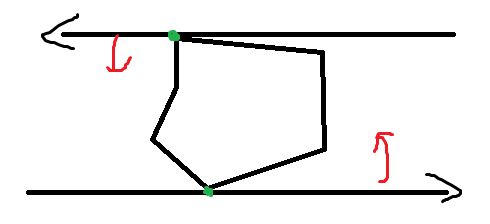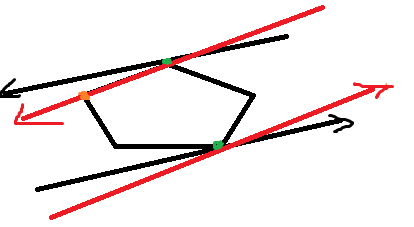1
2
3
4
5
6
7
8
9
10
11
12
13
14
15
16
17
18
19
20
21
22
23
24
25
26
27
28
29
30
31
32
33
34
35
36
37
38
39
40
41
42
43
44
45
46
47
48
49
50
51
52
53
54
55
56
57
58
59
60
61
62
63
64
65
66
67
68
69
70
71
72
73
74
75
76
77
78
79
80
81
82
83
84
85
86
87
88
89
90
91
92
93
| #include <bits/stdc++.h>
#define fi first
#define se second
using DB = double;
using PDD = std::pair<double, double>;
const int N = 50000 + 100;
const DB eps = 1e-12;
int stk[N], top;
bool vis[N];
DB ans = 1e18;
std::array<PDD, 4> as;
int cmp(DB x, DB y)
{
if (fabs(x - y) < eps) return 0;
return x > y ? 1 : -1;
}
PDD operator - (PDD x, PDD y){ return {x.fi - y.fi, x.se - y.se}; }
PDD operator + (PDD x, PDD y){ return {x.fi + y.fi, x.se + y.se}; }
PDD operator / (PDD x, DB y){ return {x.fi / y, x.se / y}; }PDD operator * (PDD x, DB y){ return {x.fi * y, x.se * y}; }
DB operator * (PDD x, PDD y){ return x.fi * y.se - x.se * y.fi; }
DB operator & (PDD x, PDD y){ return x.fi * y.fi + x.se * y.se; }
DB area(PDD x, PDD y, PDD z){ return (y - x) * (z - x); }
DB mo(PDD x){ return std::sqrt(x & x); }
DB proj(PDD x, PDD y, PDD z)
{
y = y - x, z = z - x;
return y & z / mo(y);
}
PDD rot(PDD x, DB th){ return {x.fi * std::cos(th) + x.se * std::sin(th), -x.fi * std::sin(th) + x.se * std::cos(th)}; }
PDD norm(PDD x){ return x / mo(x); }
void convex(PDD *x, int n)
{
top = 0;
std::sort(x, x + n);
for (int i = 0; i < n; ++i)
{
while (top >= 2)
{
int t = cmp(area(x[stk[top - 2]], x[stk[top - 1]], x[i]), 0);
if (t < 0) vis[stk[--top]] = false;
else if (!t) --top;
else break;
}
vis[stk[top++] = i] = true;
}
vis[0] = false;
for (int i = n - 1; ~i; --i) if (!vis[i])
{
while (top >= 2 && cmp(area(x[stk[top - 2]], x[stk[top - 1]], x[i]), 0) < 0) --top;
stk[top++] = i;
}
--top;
}
void rotcal(PDD *x, int n)
{
for (int i = 0, a = 2, b = 1, c; i < top; ++i)
{
PDD d = x[stk[i]], e = x[stk[i + 1]];
while (cmp(area(d, e, x[stk[a]]), area(d, e, x[stk[a + 1]])) < 0) a = a + 1 >= top ? 0 : a + 1;
while (cmp(proj(d, e, x[stk[b]]), proj(d, e, x[stk[b + 1]])) < 0) b = b + 1 >= top ? 0 : b + 1;
if (!i) c = a;
while (cmp(proj(d, e, x[stk[c]]), proj(d, e, x[stk[c + 1]])) > 0) c = c + 1 >= top ? 0 : c + 1;
PDD ta = x[stk[a]], tb = x[stk[b]], tc = x[stk[c]];
DB h = area(d, e, ta) / mo(e - d);
DB w = proj(d, e, tb) - proj(d, e, tc);
if (cmp(w * h, ans) < 0)
{
ans = w * h;
as[0]= d + norm(e - d) * proj(d, e, tb);
as[3] = d + norm(e - d) * proj(d, e, tc);
PDD u = norm(rot(e - d, -M_PI / 2));
as[1] = as[0]+ u * h;
as[2] = as[3] + u * h;
}
}
}
int main()
{
int n, k = 0;
PDD a[N];
scanf("%d", &n);
for (int i = 0; i < n; ++i) scanf("%lf %lf", &a[i].fi, &a[i].se);
convex(a, n), rotcal(a, n);
for (int i = 1; i < 4; ++i) if (cmp(as[i].se, as[k].se) < 0 || (!cmp(as[i].se, as[k].se) && cmp(as[i].fi, as[k].fi) < 0)) k = i;
printf("%.5lf\n", ans);
for (int i = 0; i < 4; ++i, k = k + 1 >= 4 ? 0 : k + 1)
{
if (!cmp(as[k].fi, 0)) as[k].fi = 0;
if (!cmp(as[k].se, 0)) as[k].se = 0;
printf("%.5lf %.5lf\n", as[k].fi, as[k].se);
}
return 0;
}
|

